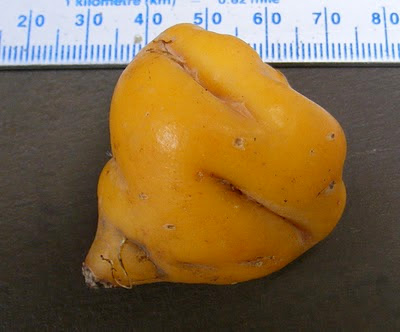Mashua, Yacon and Oca catching low autumnal sun.
It's the autumnal equinox today - the day that nominal night length overtakes day length, and apparently the first day of the year in the agriculture-based
French Republican Calendar. More importantly, it's the time of year when the Andean-tuber grower's attention begins to stray underground.
It's well known that Oca is
day-length sensitive - that is, it will only form tubers during short days in autumn. However the various authorities on the subject do not present a completely uniform front on the subject when it comes to specific timings. Here are a few quotes from respected sources:
"The common Andean types generally require days shorter than 12 hours to initiate tuber formation..."
"The optimum day-length for tuber formation in oca is 9 hours..."
"...a few researchers think that low temperatures might sometimes be more important than day length for stimulating tuberization."
" ...the ones in New Zealand (most likely originating from southern Chile in the 1860s) are apparently unrestricted by daylength."
 |
| Day length vs. Latitude vs. day of year. |
But Oca is grown in Ecuador, where days are constantly just over 12 hrs (depending on how you want to define sunrise and sunset) so in this special case day-length cannot be the trigger for tuberisation in the locally adapted varieties. With no astronomical seasons, perhaps meteorological seasons are significant, for example, the onset of a annual dry period.
It's never simple. Different varieties of oca along the length of the Andes will have evolved in response to different local conditions - so there is bound to be some variation in tuberisation triggers from variety to variety.
The furthest from the Equator that Oca is traditionally grown is about 42ºS, whereas I'm growing the crop at 51º30'N. Using the chart above, and taking say 10 hours as a threshold, my location has an earlier threshold date, but the days carry on briskly diminishing to about 8 hours, whereas at 40º latitude, the days diminish more gradually to a minimum of about 9.5 hrs. In practice, this means my location only gives a short period for tubers to form before the frost-risk of the very short days in mid winter.
Oca plants in mid-winter, with top-growth recently killed by frost.
So just like the potato when it was first brought to these latitudes, Oca needs to be given favourable microclimate conditions or protection to keep it growing into winter, well past the date when tuberisation begins. The (originally day-length sensitive) potato was adapted to European local conditions by breeding and selection, and Oca can be too, but until then it will not be reliable here as an unprotected field crop, as there is always a good chance that an early frost will finish them before the tubers are a usable size. See
Oca versus Frost post.
And if the experts cannot agree on tuberisation conditions, what about my own direct observations:
-I notice tubers start to form here from about 20th October (day length c. 10.5 hrs).
-My 9 hour day-length threshold is around 13th November. Tubers do seem to be developing fairly quickly by this date.
I intend to check more thoroughly for tuberisation dates this year to see if there is any variation between varieties.
Come on tubers, what are you waiting for?
There's a whole-world daylength calculating calendar
here if you want to check your own day-length dates.







